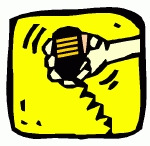Humans have always had a desire to communicate. They started out just talking to each other but then found that it was really handy to be able to write things down. This caused the invention of the alphabet and the training of English teachers to explain overly-convoluted rules of grammar.
In 1831, Joseph Henry was playing around with electric circuits and came up with the idea of a telegraph. We can imagine a simple system where ON means “time for dinner” and OFF means “not yet”. This wasn’t good enough for Samuel Morse, who invented the Morse Code which could use ON and OFF to represent the entire alphabet. This was the first digital code and was used for important messages such as “Laughing Out Loud”, later abbreviated to LOL. This was basically the same as modern text messaging but you needed a trained telegrapher to do it.
In 1875, an inventor named Bell decided that it would be better if you could just talk over the wires instead of messing around with Morse Code. This will be a recurring theme — whether to talk to other people or just send digital codes. Bell invented this thing called the telephone, which is still used today. Basically, a person could talk into one end of a wire and have his voice pop out of the other end.
Later a guy named Marconi came along with the idea that communication should not depend on wires. For example, it was quite inconvenient to drag a telephone wire behind a ship as it moved across the sea. Unfortunately, Marconi didn’t know how to do voice over the wireless, so he dropped back to using Morse Code. ON and OFF is a much easier way to go. Although there is a persistent rumor that Marconi intentionally used Morse Code to torment future generations of FCC Licensed Amateur Radio Operators, I can find no evidence of this. Some people argue that Nikola Tesla invented wireless but I think he had to be disqualified for overloading and shutting down the Colorado Springs power grid on numerous occasions.
Again, not wanting to be limited by trained telegraphers, voice communication (originally called Amplitude Modulation, but now known as Ancient Modulation) was invented. We are not sure who first came up with Ancient Modulation, but there are a bunch of radio hams on 75 Meters still trying to perfect it.
Somewhere around 1973, Motorola figured out that what the world really wanted was a portable phone that everyone could carry around in their pocket. The first attempt at this was the Motorola DynaTAC, which required an enormous pocket to carry it in. Knowing that customers were not going to enlarge their pockets, various mobile phone manufacturers worked feverishly to reduce the size of these phones.
Unfortunately, the mobile phone manufacturers terribly miscalculated, thinking that people would want to actually talk on these phones. As text messaging was added to these phones, it was discovered that most people, especially those under the age of 30, preferred to send cryptic text messages rather than actually talk to anyone. It was also discovered that all forms of human thought can be captured as 140 character messages. Although it was tempting to apply Morse Code to digital text messaging, it was rejected in favor of the ASCII 8-bit code. Instead of using ON/OFF keying, text messages are normally sent with a tiny keyboard patterned after a full-size typewriter (now obsolete).
73, Bob K0NR
P.S. I made up some of this stuff.












